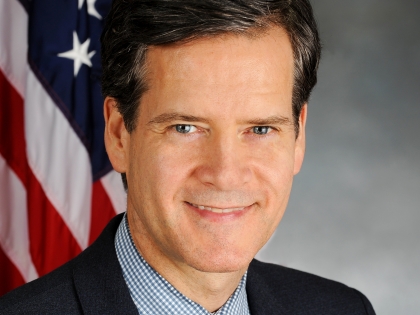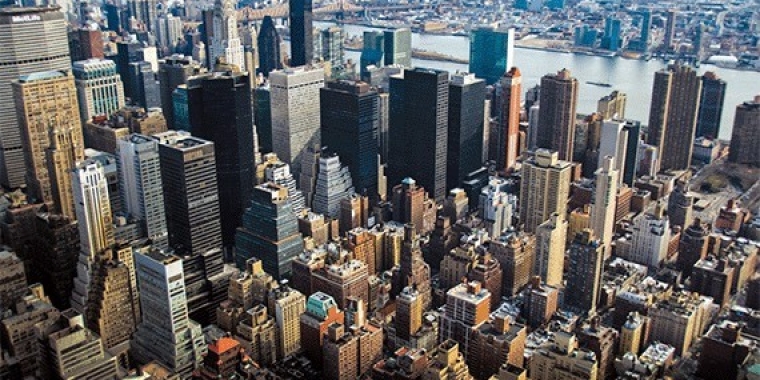
MY TESTIMONY TO THE NEW YORK CITY PLANNING COMMISSION ON THE PROPOSED GREATER EAST MIDTOWN REZONING
May 11, 2017

Thank you for the opportunity to comment on the Department of City Planning’s proposed text and zoning map amendments for a rezoning of the Greater East Midtown area. We applaud Mayor Bill de Blasio and the Department of City Planning, in close conjunction with Manhattan Borough President Gale Brewer, Council Member Dan Garodnick, and Community Boards 5 and 6, for their diligent efforts to make serious improvements to the plan to rezone East Midtown that was originally introduced under the Bloomberg administration.
While office facilities are expanded and modernized through new development in other parts of our city, East Midtown remains outdated and poorly equipped to handle the demands of modern-day business. East Midtown, once New York City’s premier business district, urgently needs better building stock, as well as transit and public realm improvements. We are grateful to DCP for coming back to the drawing board to achieve a zoning plan that will serve the business district in a rational, comprehensive, and community-minded way.
The importance of community input on a project of this scale cannot be overstated. Steering Committee members met for countless meetings where detailed and meticulous evaluation was undertaken and smart recommendations were made. We commend the Steering Committee, as well as Council Member Dan Garodnick and Manhattan Borough President Gale Brewer, for taking on the tough questions our colleagues in government, the community, and advocates have been asking.
We are grateful that the proposed rezoning incorporates many of those recommendations. However, a number of Steering Committee priorities remain omitted, particularly a required open space contribution. We strongly support the goals of the proposed rezoning plan but have a number of remaining concerns that must be addressed in the final proposal.
We ask DCP and the City Planning Commission to closely consider the following in the final stages of the Uniform Land Use Review Process (ULURP).
Open Space
We are disappointed that DCP has not seriously integrated any of the Steering Committee’s recommendations regarding public space, particularly their reasonable recommendation of a 2 FAR incentive for developers to create privately owned public spaces. The proposed zoning prioritizes other public benefits and discourages on-site open spaces through a new special permit for “public concourse” rather than allow public space to serve as a component of the toolkit for bonus floor area. Developers must expend all possible transit benefits and landmarks air rights transfers before they can apply for the public concourse permit. While the emphasis on transit improvements and landmark protections is appreciated, we do not believe that public space should be excluded from this equation.
Particularly given the dearth of public space in East Midtown, we urge DCP to make open space a priority on equal footing with the proposed as-of-right public benefit mechanisms. We hope that DCP will increase the existing plaza bonus in East Midtown from 1.0 FAR to 2.0 or 3.0 FAR. We also emphasize the necessity of making public spaces available for approval via certification rather than through special permits. The lack of open space available in East Midtown today will only be exacerbated by the anticipated increase in commercial square footage and commercial tenants. Just as this zoning proposal takes seriously the proportional needs of our transit system for a growing workforce, we urge DCP to seriously integrate the necessity for open space within the district for this same increased population.
We also note the importance of protecting the existing open space in East Midtown, particularly Green Acre Park on East 51st Street. We urge DCP to consider how this park can maintain access to light and air and protect it from the shadows of incoming developments.
Transit Improvements
We remain concerned about relying upon a local rezoning and subsequent development to fund transit infrastructure improvements that benefit the entire region. For this reason, we reiterate the request we made in our testimony on the Draft Scope of Work and ask that DCP and the MTA provide a timeline for when transit improvements will take place and how projects will be prioritized. We also ask, again, how the City plans to divorce the funds for transit improvements from a developer’s schedule. Urgently needed improvements must be made and funds must be secured before we put more pressure on Grand Central Terminal and local subway stations that cannot safely sustain existing ridership, let alone that which would result from new development.
Moreover, we are unconvinced that the minimum contribution rate of $78.60 per square foot, or 20% the value of a transaction, is set at an appropriate level. Because of the relative dormancy in East Midtown real estate and air rights transactions, we understand that the City cannot report an exact value for development rights in this area. However, we would like to see an evaluation of how the transit improvements and other public benefits justify the additional floor area gained by developers. With direct transit improvements only accounting for 10-20% of additional FAR for new developments in transit improvement zones, will the predicted funds adequately cover the necessary transit work? Without an accurate comparison of the estimated value of additional floor area gained by developers to the estimated value of the respective transit benefits, we are unable to determine whether a proper balance has been struck between boosting development and ensuring the public receives its fair share.
We would like to reiterate our request for a study that clearly analyzes the minimum contribution rate and its proportional impact on development transfers and on transit, landmark, and public realm benefits.
Public Realm Improvements
We are grateful to DOT for its innovative proposals for public realm improvements, particularly its emphasis on a new “shared streets” model. DOT’s proposed improvements take seriously the fact that East Midtown has some of the most congested sidewalks in the city, with pedestrians frequently forced into the streets during rush hour. We believe that these projects will greatly ameliorate existing conditions and help to accommodate the additional pedestrian traffic that will come with increased density.
However, we remain concerned about when these improvements will take place and how projects will be prioritized. Unlike the MTA’s transit improvements, the public realm improvements are not written into the zoning text. We hope the city will make an initial funding commitment to ensure that these improvements can be enacted. These are desperately needed improvements that cannot wait on a developer to pay for extra floor area. Similar to our concern regarding the MTA’s much needed improvements, how will the City divorce the funds for these public realm improvements from a developer’s schedule?
Additionally, we find that an increase of 5 FAR on the Pfizer site, tied to no public realm benefit, is inconsistent with the rest of the proposal and amounts to “spot zoning.” This site should be required to contribute to the public realm in the same way as any other overbuilt building in the rezoning area.
Landmarks
We appreciate that this zoning proposal makes efforts to protect our districts’ historic and cultural resources through a mechanism that allows landmarks to transfer their air rights to any location in the district. We thank DCP for including a requirement for landmarks to work with the LPC to develop a restoration and continuing maintenance plan to manage incoming funds for transferred development rights. We are also grateful that the Landmarks Preservation Commission expeditiously considered and approved 12 sites for landmarking prior to the certification of this plan. However, at least eight additional sites warrant further consideration, and we would be remiss if we did not express our concern about development on these sites, including the Vanderbilt Concourse Building, Roosevelt Hotel, Lincoln Building, Postum Building, Hotel Intercontinental, and Chemists Club. Unless the LPC is willing to see these historic sites demolished for incoming development, it should assure their survival with landmark designations.
We reiterate our concern regarding the minimum contribution rate. We urge DCP to consider how a minimum floor price may potentially disadvantage landmarks, including an examination of more cautious proposals for a minimum floor price that will ensure landmarks receive the necessary support and funding from incoming development.
Daylight Evaluation
DCP recently implemented changes to the daylight evaluation scoring system that measures the impact of height and setback and the degree of “sky exposure” left by a building, including how much daylight can reach the street. The Steering Committee recommended that the passing score be reduced from 75 to 66, under the scoring system of the Special Midtown District. We believe that this is a reasonable compromise and urge DCP to reassess the newly adopted daylight evaluation methodology. We would also like to see an analysis of the scoring system alterations and the impacts on the rezoning in East Midtown. How will increased FAR be balanced with existing daylight evaluations?
With a significant anticipated net height increase of a number of structures in the proposed rezoning area, we urge DCP to consider how the plan can mitigate increases in large shadows cast by buildings onto already sunlight-sensitive resources. One step that would help to fulfill this request would be the lowering of the daylight evaluation passing score to the level recommended by the Steering Committee.
East Side of Third Avenue
We reiterate CB6’s request to omit the area east of Third Avenue from the rezoning area. Any development in this area should be built in context with the nearby residential neighborhoods Turtle Bay and Tudor City. Implementing a 20% limit on residential use for “qualifying sites” here contradicts Third Avenue’s role as a mixed-use area that transitions the streetscape from its commercial uses to the west into more residential areas to the east.
Moreover, until the Second Avenue Subway can be extended farther south, this area does not have the capacity for the increased density possible under the proposed rezoning. The rezoning proposal only excludes the east side of Third Avenue on the midblock between 47th and 48th Streets and does not meaningfully address the conflict between increased residential use in the area and the proposed rezoning’s focus on commercial uses.
Reasonable Worst-Case Development Scenario
We continue to question some of the criteria used in the DEIS to exclude sites from the Reasonable Worst-Case Development Scenario. The DEIS, like the scoping document, excludes all condominium, co-op, and rental buildings with more than six rent regulated units from the list of projected and potential development sites. In recent years, we have seen developers in our districts manage to buy out all the owners and/or rent regulated tenants in buildings to be able to redevelop the sites. We believe that these buildings will be vulnerable to development and should be evaluated as part of the Reasonable Worst-Case Development Scenario.
Socioeconomic Conditions
Finally, we hope that a final proposal will comprehensively analyze any potential for direct or indirect business and residential displacement, as well as how the modernization of building stock will diversify the existing commercial tenants in the area. We also emphasize the importance of ensuring the incoming development pays mind to existing commercial building service worker jobs and sustains a steady stream of jobs in the business service industry.
Thank you for your time and consideration of our comments.